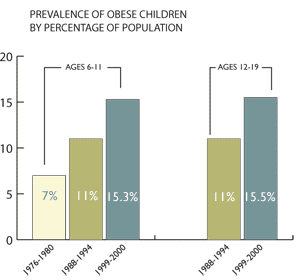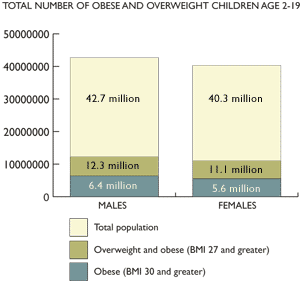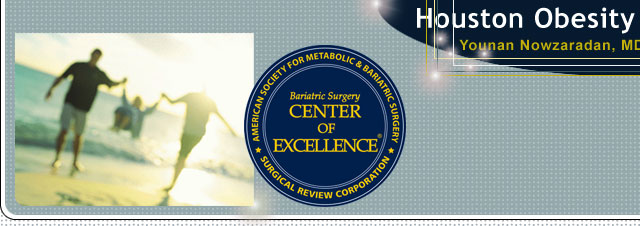
| Epidemic Statistics According to latest statistics report, since the 1970s, obesity in teens has tripled from 5 percent to 15 percent. The US Department of Health estimates that 50% of children under the age of 12 are obese, a statistic that has nearly doubled in the past 20 years, with even 2 and 3-year olds falling victim to the disease of obesity. In 1999-2000, over 10 percent of younger preschool children between ages 2 and 5 were overweight, up from 7 percent in 1994. The prevalence of overweight and obese children has steadily increased over the years among both genders, all ages, all racial/ethnic groups, and all educational levels. This is an alarming situation as it indicates an increase in the risk of various serious diseases associated to obesity or being overweight. |
The Center for Disease Control (CDC) reports that among children ages 2-19, 23.4 million are overweight or obese (BMI of 27 or above). Of those, 12 million are obese (BMI of 30 or above). An additional 15 percent of children and 14.9 percent of adolescents were at risk for becoming overweight based on BMI measures. | |||
 |
 |
|||
| Aging Before Their Time Childhood obesity-related diseases in the United States have also grown. Type 2 diabetes, for example, was rarely seen in juveniles a decade ago, but has risen from 4% new cases seen in the pre-1990's to between 8-45% during the 1990's. In addition the incidence of a single risk factor for heart disease has also risen to nearly 60% of children between the ages of 5 and 10 years old who are obese. Not only that, but those with at least 2 risk factors has also risen to 25%. Some of these risk factors are those that generally we associate with the elderly; high blood pressure, high cholesterol, and high triglycerides. These children are having diseases at 5 and 10 years old that in the past took decades to get. Childhood obesity is becoming an epidemic and should be a concern for all adults, especially parents. Environmental Influences According to the organization “Parents Preferred Nutrition Guidelines”: Over the past ten years school systems have found another way to disregard the nutritional health of our children by joining with large corporations to place vending machines that sell junk food in our public schools. Our schools furnish our children with access to junk food, but not with a physical fitness program. Vending machines are big business. About half of the nation's schools districts have vending machine contracts with soft drink companies to help fund extracurricular activities. Some school districts receive hundreds of thousands of dollars up front from large corporations just to sign an exclusive contract with a company. This type of big money is not just being paid to big city school districts. Princeton City School District in Ohio received $136,000 up front from Coke-Cola for a 10-year contract, and receives 40 percent of all sales ($18,000 last year) from the machines. Coke and Pepsi are now involved in a court battle over a contract that was signed by a school system then was later broken so the school could sign for more money with another company. In an effort to combat this trend, the CDC and Council for Physical Education for Children recommended:
Benefits of Lifestyle Changes |
Negative Impacts Beyond the Physical Obesity can be socially devastating for children as they are marginalized from school and extracurricular activities, especially sports which, ironically, would most benefit their health. As children develop socially, they tend to compete for positions of dominance within their peer groups. Typically, those seen as being ‘different’ or less than ideal are targeted for psychological and verbal abuse by their peers. While this is not to say that children, or adults, should always strive to blend in or be part of the pack, it is worth considering the long term psycho-social impact such abuse may have on our children. Social inadequacy can lead to further socialization issues in adulthood, depression, withdrawal, poor academic performance, and even suicide. An estimated 75% of obese adolescents will continue to be obese in adulthood. Bariatric Surgery and Children In extreme cases, as with that of Billy Robbins, a super-morbidly obese 19-year-old adolescent, bariatric surgery was deemed a necessity if he were to make it to his next birthday. Billy weighed in excess of 800 pounds when he first presented to Dr. Nowzaradan. His situation was so extreme, that Dr. Nowzaradan, Billy and his family decided, after weighing the risks and benefits, to undergo a 2-stage procedure involving an initial Sleeve Gastrectomy, followed by a malabsorptive bariatric procedure. In extreme cases, surgery may certainly be considered for an adolescent; however, this situation should not be entered into lightly. Intense scrutiny of all health and psychological variables is necessary prior to surgery. Solutions at Home Make sure healthy foods are readily available, and remove high-calorie, high-fat foods, such as chips, cakes, ice cream and soda from the home. Many parents are just as taken in as children when it comes to creative marketing. A Fruit Roll Up is NOT the same as an apple. Today, television, video games, and computer activities have become the babysitter for our children, resulting in kids living a couch potato lifestyle, thus making physical activity less common. Creating new family habits around healthy eating and increased physical activity can help children lose weight and gain self-confidence. This will also improve the health of other members of the family including yourself, by setting good examples of a healthy lifestyle. Physical activity can be a great way to spend quality time with your children: A walk at the park, playing with your child on the playground, riding bikes, playing a game of freeze tag, running a race up a hill, or playing a game of baseball. Just get your kids moving! It is so important for the health of your entire family. |
|||

